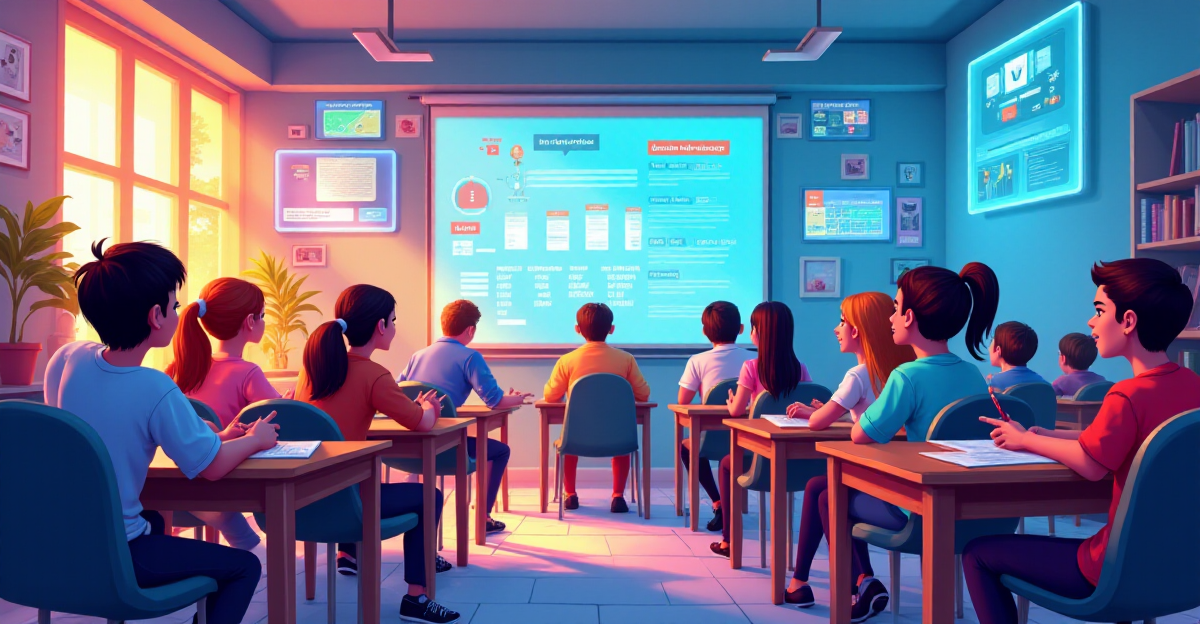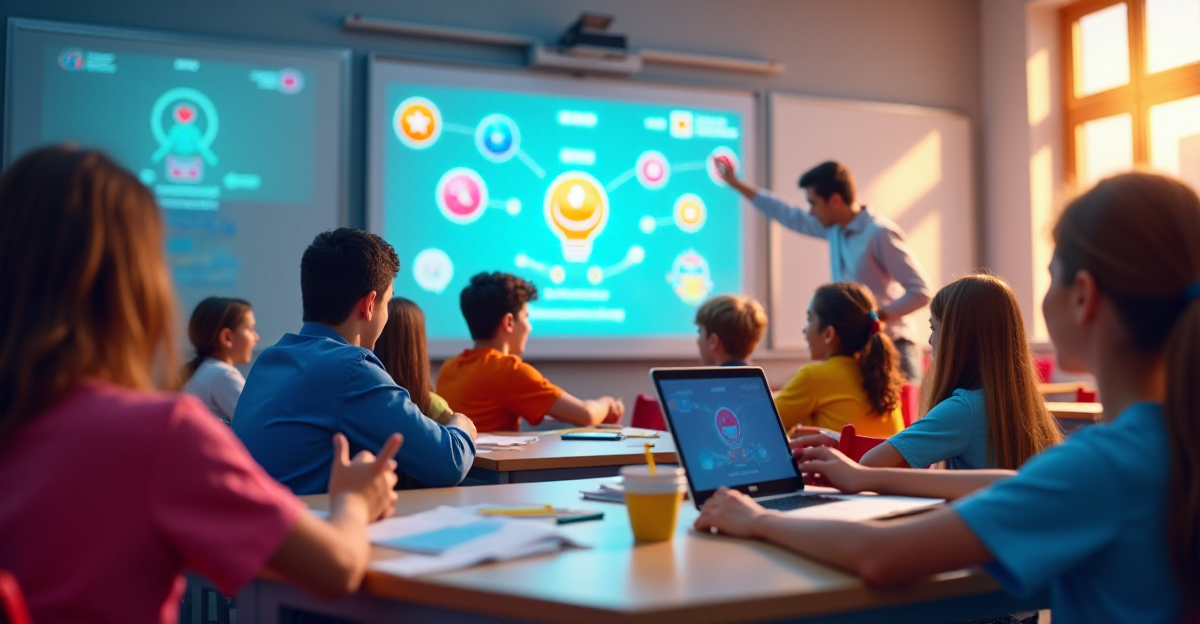An innovative teaching tool called gamification uses game-based components to involve and inspire pupils. This paper explores how gamification with rewards, challenges, and level-based advancement turns conventional education into participatory events. When we consider my own experience with gamified projects, we will go over how these approaches could inspire passion and increase retention. By means of useful examples and advice, this paper provides teachers with understanding of implementing game mechanics in a range of disciplines, therefore guaranteeing that students remain active participants in their education.
Table of Contents
- Gamification in Education: How to Make Learning Fun and Engaging
- The Benefits of Gamification in Education
- How to Implement Gamification in the Classroom
- Extra’s:
Gamification in Education: How to Make Learning Fun and Engaging

Imagine a classroom in which students are driven to reach their academic goals, actively engaged in courses, and ready to learn. This is reality that gamification in education can help one reach, not only a dream. Gamification adapts the interesting aspects of video games to non-game settings, such as learning, therefore enhancing and rewarding education.
This method can turn conventional classrooms into dynamic learning spaces in which students really enjoy their education. Teachers can inspire a love of learning by including game mechanics including points, badges, leaderboards, and challenges, so leveraging students’ inherent drive for competition, rewards, and completion.
Harnessing the Power of Games for Education
Creating interactive learning opportunities that mimic games is one of the most successful approaches to apply gamification in education. My teacher in a biology class once showed us a virtual ecosystem simulation to help us understand several kinds of environments. Designing our own virtual ecosystems was our assignment; points were awarded for producing varied habitats and include several species. Learning this practically rather than from a textbook was lot more interesting. In an interesting and entertaining manner, we discovered the interconnections among many species and the value of biodiversity.
There are several disciplines and learning goals for which gamification fits. Popular teaching tools including SimCity and Minecraft give students interesting venues to study urban planning, resource management, building construction, and problem-solving. For kids to experiment, make errors, and grow from their experiences in a safe and engaging setting, these games offer Minecraft lets kids create buildings, explore other worlds, and work with others, so developing their ingenuity, problem-solving ability, and teamwork. Through creating their own virtual towns, students in “SimCity learn about urban planning, economics, and resource management.”
Successful gamification in education depends on customizing the game mechanics to the particular learning goals and student interests. Teachers that use this strategy can design more interesting courses that support student motivation and improve classroom techniques, therefore transforming the learning environment and igniting a passion of knowledge in each of their pupils.
The Benefits of Gamification in Education

Imagine a classroom humming with activity, students fixed on their screens, not because they are playing video games but rather because they are engaged in interactive learning, meant to make learning more fun and efficient. Gamification in education has great power. Teachers may create a dynamic classroom where students are driven, pushed, and eager to learn by including interactive elements—points, badges, leaderboards, and challenges—into learning activities.
Increased Student Engagement and Motivation
Interactive learning makes learning more interesting, which boosts student motivation and a stronger want to engage in class. Students get to level up, gather virtual rewards, and even challenge their peers on leaderboards rather than feeling as though they are merely finishing homework. This can help learning seem less like a chore and more like a game. By customizing their lesson using interactive elements, teachers can also provide challenges and incentives fit for each student’s particular learning style and interests.
Using Interactive Elements in the Classroom
One can find countless ways to include interactive elements into the classroom. Teachers might design interesting quizzes using online tools like Kahoot! that transform learning into a game. They can also design escape rooms whereby students must work together to unlock the last clue and solve riddles. With interactive elements, even basic chores like reading comprehension or writing assignments may become fascinating events. Imagine a virtual treasure hunt which students must locate hints buried inside a book to access a prize at the conclusion!
Improved Learning Outcomes and Retention
Studies of interactive learning reveal improved learning results. Students are more likely to grasp and remember the content since they participate actively in their education and get regular comments. Interactive learning also helps kids acquire critical thinking, problem-solving, and teamwork among other vital abilities. Students that engaged in a gamified learning program shown notable gains in their grasp of scientific ideas, according one University of California, Berkeley, research.
Fostering a Positive Learning Environment
Gamification in education offers one of the most significant advantages in that it fosters a favorable learning atmosphere in which students feel free to experiment, take calculated chances, and make mistakes. Embracing interactive learning helps students to be creative, try several strategies, and grow from their errors. Many gamified activities’ cooperative character also encourages among pupils social interaction, communication, and teamwork.
Personalized Learning Experiences
Gamification is a special chance for every student to customize their educational process. Customizing interactive learning environments to the particular learning goals and interests of every student guarantees that everyone has the chance to flourish and achieve. A teacher might design a customized interactive learning exercise for a student having trouble grasping a given idea, for instance. This can entail playing a game designed especially for that idea therefore giving the pupil chances to develop and master the talent.
Call to Action
Think about including interactive elements into your classroom if you are a teacher trying to make your lessons more interesting and successful. Clear advantages of gamification in education are more student motivation, better learning results, and a more favorable learning atmosphere. From online platforms and instructional games to particular equipment that might gamify your classroom, there are many options at hand to assist you in starting. So why not try interactive learning and see how much it might benefit your pupils?
How to Implement Gamification in the Classroom

Imagine arriving into a classroom humming with activity where learning is an exciting journey rather than a drudgery. That’s the ability of gamification to transform conventional classrooms into dynamic, interactive learning spaces. Incorporating game-like components including points, badges, and leaderboards helps gamification increase student engagement and motivation, hence improving the efficacy and enjoyment of learning.
Creating a Gamified Learning Environment
Good gamification depends on creating learning opportunities that resemble games. This maintains pupils’ active interest and motivation. Consider including these components into your presentations:
- Award points and badges: Give points for completing tasks, answering questions correctly, or actively participating in class. You can even create a system of badges for achieving specific goals, such as completing a project on time or demonstrating mastery of a particular skill.
- Use leaderboards: Use online platforms or even a simple whiteboard to create leaderboards that track student progress and create a healthy sense of competition.
- Design engaging challenges and quests: Create challenges that require students to apply their knowledge and skills. You can design quests where students have to complete a series of tasks to unlock rewards or achievements.
- Offer virtual rewards: Give students virtual rewards, such as virtual currency, special character skins, or access to exclusive content, for achieving milestones or demonstrating excellence.
Practical Examples of Gamification in the Classroom
Let’s explore some actual case studies of using gamification in the classroom:
- History: Picture this: a virtual escape room where students must solve clues related to historical events to unlock the final answer. This engaging activity combines problem-solving, critical thinking, and teamwork, transforming history into a thrilling adventure.
- Science: Design a virtual ecosystem game where students create their own ecosystems and compete for points based on biodiversity and sustainability. This hands-on approach allows students to learn about ecological principles while fostering a sense of responsibility for the environment.
- Language Arts: Use a gamified quiz platform like Kahoot! to turn vocabulary tests into interactive and engaging games. This fun and collaborative format makes vocabulary learning enjoyable and memorable.
- Math: Try a Math Olympics where students compete in different math challenges and earn points for achieving a certain level of accuracy. This activity promotes friendly competition, encourages teamwork, and enhances mathematical skills.
Students should be urged to own the gamification process as well. Ask them to create original game challenges or propose fresh game concepts for particular disciplines. This interactive method can help gamification to be even more successful and interesting.
Tips for Successful Gamification
Here are some ideas to help gamification in your classroom be a great success:
- Tailor gamification to your students: Make sure the game mechanics you use are relevant to the subject matter and the interests of your students. For example, if you’re teaching a class about ancient civilizations, a virtual adventure game where students explore ancient ruins could be a highly engaging way to learn.
- Set clear goals: Explain the learning objectives clearly and how game mechanics will help students achieve them. Students should understand how the points, badges, and challenges they’re engaging with are directly related to their learning goals.
- Provide feedback: Regularly provide students with feedback on their progress, using game mechanics to highlight their achievements and areas for improvement. Use leaderboards to show students their progress, or award badges for specific achievements.
- Keep it fun: Remember that the goal is to make learning enjoyable, so don’t take it too seriously. Let students have fun and be creative with their participation.
Gamification might completely transform learning. Including game concepts into your instruction will help to make learning more effective, dynamic, and interesting. It’s a great approach to enable students to own their education and meet their academic targets. Would you want to try gamification in your classroom? Your students’ love of it may astound you!
Extra’s:
To further explore innovative teaching methodologies that resonate with modern learners, consider delving into our comprehensive guide on “Engaging Students Through Project-Based Learning.” This approach emphasizes hands-on activities and real-world applications, fostering deeper engagement and knowledge retention. For a contrasting perspective, delve into “Flipping the Classroom: A New Approach to Student Engagement,” where we dissect the transformative power of inverting traditional classroom dynamics.
For a deeper understanding of the research behind gamification in education, exploring external resources is crucial. “ResearchGate – Temporarily Unavailable” offers a platform for academic research, providing insights into the effectiveness of gamification in diverse learning contexts. For practical examples of gamification in action, “5 Best Examples Of Gamification In Elearning | Examples” showcases real-world applications that can inspire educators to incorporate game-based learning elements into their classrooms.
Keywords:
gamification, education, interactive learning, student motivation, classroom techniques
Meta description:
Explore how gamification in education enhances student engagement and makes learning interactive and fun.
Focus Keyphrase:
Gamification in Education












1 thought on “Unlocking Student Potential Through Gamification in Education”